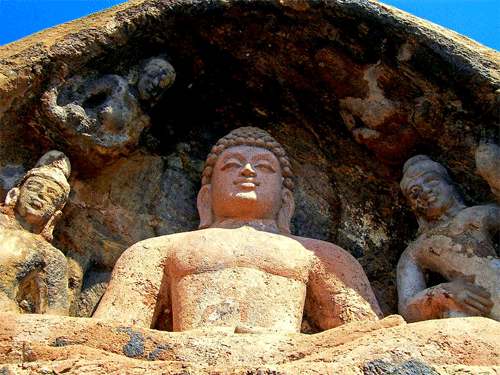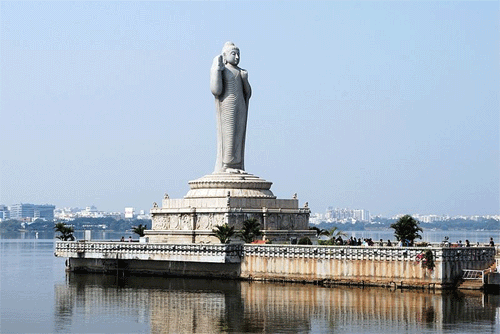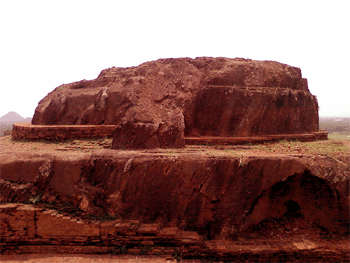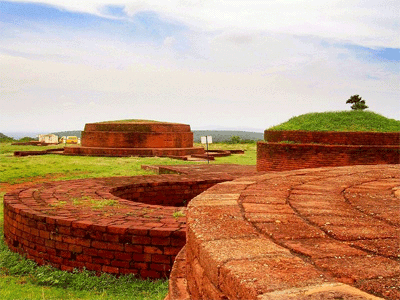 Though Ashoka was responsible for spreading Buddhism in Sub-continent, Satavahanas, Ikshvakus and Vishnukundins of Andhra take the credit for spreading Buddhism in the Andhra in a big way. The following example speakes volumes of influence of Buddhism in Andhra as early as 2nd century. From this one can infer, that Busshism reached the land of Andhra even when Goutama was alive.
Though Ashoka was responsible for spreading Buddhism in Sub-continent, Satavahanas, Ikshvakus and Vishnukundins of Andhra take the credit for spreading Buddhism in the Andhra in a big way. The following example speakes volumes of influence of Buddhism in Andhra as early as 2nd century. From this one can infer, that Busshism reached the land of Andhra even when Goutama was alive.
Buddham is a hamlet near Bapatla in Guntur district. The very name of the village gave it a speciality for not only does it carry the name of Gautama Buddha but every home innthis village has some Buddhist relic in some part or corner of the house.
The Satavahana kings of Andhra ruled with Dharanikota or Dhanyakataka as their capital, whose modern name is Amaravati wae hub of Buddhist activities.
From Amaravati many routes were spread for the interest of the trade in different directions. And its on these routes scores of Buddhist sites came up which speak of the golden and glorious era of Buddhism in the state of Andhra Pradesh.
Some of the prominent places which were the epicentres of Buddhist glory are Jaggayyapeta in Krishna district, NelaKonda palli in Khammam district. Panigiri in Nalgonda district and Dhulikatta in Karimnagar district.
The road towards east of Amaravati leads to Aluru, Krishna district, Guntupalli , West Godavari district, Kattipudi, East Godavari district6, Bavikonda, Visakhaqpatnam district, Ramatirtham , Vizianagaram district and Salihundam, Srikakulam distrct.
The southward journey from Amaravati will take you to the great Buddhist havens, Chinaganjam of Prakasam district and Nandaluru og Cuddapah district.
Each place mentioned above are the biggest tourist attractions. The most heartening aspect of all the above places is, they are all accessible from major towns and cities.. Places like Salihundam, Ramatirtham and Simhachalam can be approached from the most developed city of Visakhapatnam. The advantage is that touristss can carry on their tours by staying in Visakhapatnam and availing the star facilities of a big city. In Visakhapatnam also known as Vizag,
Buddhist pilgrimages like Amaravati, Nagarjunakonda, Bhattiprolu, Buddham and Guntupalli are nearer to Vijayawada, a big business centre having many star hotels and inexpensive staying places suitable to every pocket. For those tourists who wish to visit the famous Buddhist relics in Panigiri and Dhulikatta, Hyderabad, the state capital is the place from where these places can be reached.
The Monolith Buddha

The massive monolith of Buddha that stands in the Hussain Sagar lake in Hyderabad, is a classic example of sculpting, The renowned sculptor Ganapati Stapathi with his 40 able sculptors toiled hard to carve out the statue of the Buddha from a single rock at Raigiri 60 km away from Hyderabad in the district of Nalgonda. The statue weighing over 320 tons was brought from Raigiri to Hyderabad on a specially designed trailer with 200 wheels. The trailer took two full days to travel the distance of 60 km. The finishing was done in Hyderabad.
As luck would have it, the giant Buddha had a fall while finishing touches were going, and resulted in the sinking of the monolith Buddha. It took 2 years to take out the Buddha from the Sagar waters and install it oin a pedestal in the middle of the lake Hussain Sagar. Ever since the installation of Monolith Buddha, it has become a star tourist attraction in Hyderabad.
Trivia about Monolith Buddha
- its the world's tallest monolith of Buddha
- A big search was conducted to find a suitable Granite for carving the Buddha.
- It took 5 years to complete.
- The government of Andhra Pradesh spent 3 million dollars
- The statue's height is 58 feet
- The Buddha stands on a concrete platform measuring 16 SQ, ft. which is now known as 'Rock of Gibralter.'
- In order to make the statue reach the centre of Hussain sagar, the approach roads were also had to be widened.
Nagarjunakonda
A valley in the Nallamala ranges in the Guntur district, 150 km away from the capital is well known for Buddhist Chaityas and Viharas. The place derived its name from a Buddhist monk Nagarjuna, who lived here around 2nd century AD.Nagarjunakonda is located in a place that overlooks the world famous largest masonary dam in the world Nagarjunasgar.. Nagarjunakonda can be reached from Hyderabad and Vijayawada. Its original name was Sriparvata. In rhe close proximity of Nagarjunakonda Vijayapuri is located which is the capital of the Ikshvaku rulers who ruled in the 3rd century A.D.
An interesting feature
When Archaeologist A.R. Saraswati discovered Nagarjunakonda in the year 1926, the Archaelogical survey of India carried out excavations lasting for 4 years and unearhed many Buddhist monasteries. But later after 30 years, the famous Nagarjunasagar project was mooted and finalised.
It meant submersion
Nagarjunakonda was destined to be submerged?
No, the archaeological survey determined not to allow Nagarjunakonda sink. The survey salvaged many ruins. Nine monuments were transplanted from the valley to a hill, which has become the new abode of Nagarjunakonda. Buddhadhatu or the relics of Buddha evcavated from the valley are being housed in a museum at Nagarjunakonda.
Amaravati
In the close proximity of Nagarjunakonda, Amaravati, another Buddhist pilgrimage site is located. Like Nagarjunalonda, Amaravati is also located in Guntur district.For the first time in the year1797 the Buddhist ruins were unearthed. After this excavation and many subsequent excavations revealed that a great school of art existed here.. The findings in the excavations at Amaravati arenfound to be a wealth of informtion related to the then conditions existed.Many sculptures of highest sculptural values were preserved in the museum at Amaravati.. Unfortunately most of the cultural wealth unearthed during the excavationsb were taken away by the government museum at Chennai and British museum at London..
Bhattiprolu
Not far from Amaravati and from the same district of Guntur, there is another Buddhist pilgrimage with the name Bhattiprolu which houses an nctient Stupa. This Stupa is believed to be of pre- mauryan period. This Stupa which was built by the rich people contains events in the life of Buddha. Time has taken its toll. Much of the famous Stupa is under the ruins. But for a brick mound and a few marble pillars everything is in rubles.
The patch between Amaravati and Nagarjunakonda is infested with many sites of Buddhist importance. Some of them are
In a village known as Chejerla near Narasaraopeta, a Kapotiswara temle of the 6th century is believed to have come up over a site where a Buddhist temple was earlier located.
At Chebrolu close to Guntur, it's believed under the Bhimeswara temple, there was a Stupa.
In Velpuru near Sattenapalli, in the Ramalingeswara Temple, many of the marble pillars are believed to have been linked with the Buddhist era.
Guntupalli
Guntupalli located near Eluru district headquarters of west Godavari. A hillockat Guntupalli was known to be a Buddhist settlement. This place is surrounded by serene surroundings. This settlement is known as Vengi, which was believed to have been visited by the famous Chinese traveller Hieun Tsang in the middle of 7th century. Vengi is the capital of Andhra during Satavahana period. Vengi is the place according to Historians, is infested with Buddhist sites, though many of them are buried under mounds.
Visakhapatnam a centre for Buddhist Pilgrimages
Archaeologists were very excited by the findings from the excavations in the northern part of Coastal Andhra Pradesh. It amazed many arcgaeologists to find a rich haul of Buddhist pilgrim sites of national importance.Many of the sites were excavated earlier. But latest excavations are
Bavikonda,
Bavikonda is located on a hill close to Timmapuram 16 km from the port city of Visakhapatnam. BAVI means well. There are many wells designed to cater to the needs of the Buddhist monks. It's dueb tonthis reason , the place has become popular withbthe name 'Bavikonda.' Bavikonda is a big Buddhist complex with walls plastered with lime. An urn , in which a bone was found has been unearthed.It was believed to be a part of mortal remains of the Buddha,. Roman coins along with Satavahana coins
Thotlakonda
Very near to Bavikonda, Thotlakonda is located. Its located 15 km from Visakhapatnam on the way to Bheemli town on a hill overlooking the sea. A hilly location overlooking the sea is the favourite venue for a Buddhist monk. It has a similarity with Bavikonda with regards to rain water collection in wells for the usge of Buddhist monks.Like Bavikonda, Roman coins were found. This signifies the foreign trade on the Satavahana days,
Pavurallakonda
Pavuralla konda also known as Pavurallabodu is the name of a hill. Local people call this hill as Narasimha swamy konda. Pavurallakonda is near Bheemunipatnam and 25 km away from Visakhaptnam.. A ruined Buddhist Monastery was found on Pavurallakonda where it was believed Hinayana Buddhism existed.Two inscriptions in Brahmi label were found along with many rock-cut cisterns meant for water storge were found.The Indian National trust for arts and culturl heritage INTACH appealed to the authorities to take up Bavikonda, Thotlakonda, Pavurallakonda and Bojjannakonda under the wings of UNESCO as Heritage sites.
 Bojjannakonda
Bojjannakonda
Bojjannakonda is a Buddhist site that exists along with another Buddhist site Lingalakonda on adjacent hillocks.Both these Buddhist sites are located near a village called Sankaram about 45km from Visakhapatnam.Both the sites are believed to have been existed between 4th and 9th centuries AD.During this period History says that all the three phases of Buddhism, Hinayana, Mahayana and Vajrayana flourished.
Bojjannakonda is a haven for large monolithic Stupas. The dome or top portion of the Stupa was built with bricks. One can see these Stupas are surrounded by rock cut and Brick Stupas and small chaityas. In Bojjannakonda there are 6 rockcut Stupas. Some of the Stupas are adorned with sculptural panels. All the sculptural panels consist of a seated Buddha surrounded by attendants.
The other part of Bojjannakonda is known as Lingalakonda. A large number of antiquities were recovered in the excavations conducted under the leadership of Alexander Rea in the year 1907-1908.
All the Biddhist sites around Visakhaptnam flourished during 3rd century BCE to 3rd century CE. After that with the revival of Hinduism, Buddhism started declining.INTACH, Indian National Trust for Art and Cultural Heritage appealed the authorities to request UNESCO for declaring the Buddhist sites Bavikonda, Thotlakonda, Pavurallakonda and Bojjannakonda as the Heritage sites.
Archaeological Survey Of India is maintaining most of the Buddhist sites. APTDC, Andhra PradeshTourismDevelopment Corporation is doing its part by providing world class facilities along with its well structured staying and fooding infrastructure to the tourists.
